

Statement of problem: Movement of impression
copings inside the impression materials prevents
transfer of the 3-dimensional spatial orientation of
intra-oral position of implant fixtures to the working
cast. .So for the long term success of implant an
accurate and passive operation is required.
Purpose: This in vitro study evaluated the accuracy
of the master cast using different splinting and
impression materials.
Methodology: A reference mandibular model with
4 internal connection implants was fabricated.
Thirty six custom trays were fabricated using
autoplymerizing resin. Polyether and poly vinyl
siloxane impression material were used. These trays
were randomly divided between the two groups, with
eighteen trays in each group. Impression techniques
were divided into two groups namely: Group I: Direct
impression technique with open tray impression
copings splinted with autopolymerizing acrylic
resin (GC pattern resin). Group II: Direct impression
technique with open tray impression copings
splinted with Pro‑temp TM 4 (bis‑GMA) syringable
temporization material. Thus, final impressions were
made. Master casts were fabricated and evaluated
using profile projector. These measurements were
compared to the measurements calculated on the reference mandibular model which served as control.
Data were analyzed with a one way analysis of variance
at a =.00, followed by post hoc Tukey’s test test (a=.00).
Results : Statistical comparisons were made using
ANOVA test and post ‑hoc test. Same amount of
deviation values obtained with resin splinted and
bis‑GMA splinted impression copings. There was a
significant difference in-- while using Polyether and
poly vinyl siloxane as impression material.
Conclusion: The master cast obtained by both the
splinting material exhibited no difference from the
reference model. In the direct techni¬que, polyether
showed better results in terms of accuracy. Splinting
provided more accuracy of transfer in multiple abutments
using both the impression materials included in the
study .Both splinting materials showed comparable
amount of deviation from the reference model, any
one of the material based on the ease of handling, time
consumption, technique sensitivity and availability
can be chosen.
Key words: Accuracy, Open tray implant impression, Master cast, Splinting materials
Dental Implants have bought revolutionary
changes in treatment of partially and completely
edentulous patients. Implants are different from
natural teeth as osteointegrated. Implants have
no periodontal ligament to compensate for any
accuracy. As implants are functionally ankylosed
with direct contact to the bone, they lack the
inherent mobility of periodontal ligament. Hence,
they cannot accommodate distortion or misfit at
the implant abutment interface.1 Consequently
recording the intraoral three-dimensional position
of implant is more challenging in the realization
of implant-supported than in tooth-supported
prosthesis to ensure an accurate relationship
on the master cast. A successful result can be
achieved only when passively fitting prosthesis
are fabricated.2 Poor fit of framework connected
to implants may lead to bone loss and failure of
implants causing problems ranging from screw
loosening to loss of osteointrigation.3
The adaptation precision, between prosthetic
infrastructure and implant or tooth is one of the
great challenges of oral rehabilitators.4
Impression materials and techniques are
fundamental in precision of fit and passivity of
implant supported FDP’s5. Accuracy of impression
is affected by the selection of impression tray that
might be a stock tray or custom tray. Impression
techniques like close tray or open tray and type of
impression material also attributed to accuracy.
In case of impression procedures, most of the
researchers reported that the open-tray pick-up
technique is more precise and predictable than
the closed tray technique using repositionable
copings6.
A factor that can contribute to the imprecise
transfer of impression copings is a deficient
splinting technique. Theoretically, splinting is
done to prevent the copings from becoming
dislodged during impression making and during tray removal.
Therefore the purpose of this study was to compare
the implant cast accuracy of multiple implants
using different splinting and impression material
combinations.
A reference model with four implants (Bio TEC,
Dental implant system,Germany) in the mandibular
anterior region in overdenture situation were
placed using surveyor for proper orientation of
implants. The implants were numbered 1,2, 3 and
4 for reference purpose. Custom impression trays
were made with autopolymerizing methacrylate
resin (DPI Self cure resin). For this purpose, the
4 implants (Bio TEC, Dental implant system,
Germany) in the model were covered by 2 layers of
wax sheet (Charminar Dental Products, Hydrabad,
India) to allow a consistent thickness of impression
material, and an irreversible hydrocolloid
impression (Alginax, DPI, Mumbai) was made
to obtain a single cast on which all custom trays
were fabricated. Tissue stops were incorporated
between each implant. Three location marks
(circular depressions 2mm wide and 1mm deep)
were made on the base of model and included in
the impression trays to standardize tray positioning
during impression making. Windows were made
in the impression trays for open tray technique to
allow access for the copings screws. (Fig: 1)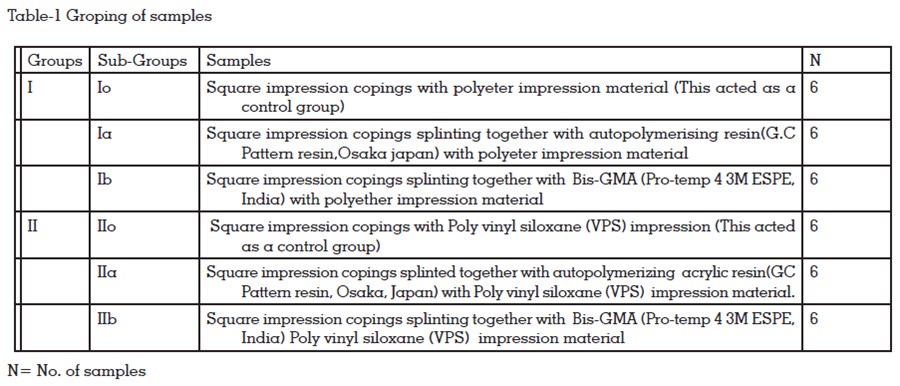
Splinting was done with different materials to
fabricate specimens Group Io samples were
fabricated, with polyether impression material
without splinting square impression copings.
Groping of samples and material details as
follows :
For groups Io, Ia & Ib 18 medium-consistency
polyether impressions (Impregum Penta, 3M
ESPE, Germany) were made. For obtaining
impressions, impression trays were coated with
tray adhesive (Impregum, 3M ESPE) 1 hour before
each impression was made. The impression material was mixed using penta elastomer syringe
(3MESPE pentamix 2 Germany), and part of the
material was meticulously syringed around the
impression copings to ensure complete coverage
of the copings. The remaining impression material
was used to load the custom tray. The custom
trays were fully seated over the resin model with
finger pressure, and the position was maintained
throughout the polymerization time.
In the group Io, impression copings as supplied by
the manufacturer were used (square impression
copings, without splinting) Polyether was used
as an impression material. Each custom tray
was seated, and the material was allowed to
polymerize. The guide pins were released so that
the transfer copings remained in the impression
when the impression was removed.
In the group Ia, impression copings were splinted
with autopolymerizing acrylic resin (GC Pattern
resin, Osaka, Japan) .For this copings were splinted
with dental floss (Oral B waxed dental floss, India)
(Fig-2). Autopolymerizing resin (GC pattern resin,
Osaka, Japan) was mixed in the ratio of 2 g–1 ml.
When the resin reached the dough stage, it was
packed around the impression posts and the dental
floss thus they were splinted together. The splint
was allowed to polymerize for 4 min. The splint was then sectioned in between the impression
posts using a thin separating disc to relieve the
stresses caused due to polymerization shrinkage.
The cut sections were joined using the same resin
by applying it using brush bead method(Fig-3).
This was again allowed to polymerize for 4 min.
The impression copings, custom tray, and the splint
were coated with polyether adhesive and allowed
to dry for 15 min. The impression procedure was
accomplished as previously described.
In the Ib group, impression copings were splinted
with Bis-GMA (Pro-temp 4 3M ESPE, India) and
the impression procedure was accomplished as
previously described (Fig-4).
For the open tray technique, the guide pins were
loosened with a hex driver (EZ Hi-Tec, Life Care
Devices) and removed, the tray was separated from
the definitive model, and the impression copings
along with the guide pin remained locked in the
impression. The implant analog was connected to
the hex at the bottom of the impression coping, and
the guide pins were tightened with the hex driver.
In the IIo, IIa, and IIb groups VPS impression
material was used. The procedure for these 3
techniques was the same as for the first 3 groups.
The custom trays were painted with VPS adhesive (VPS Tray Adhesive, 3M ESPE, St Paul, Minn) and
allowed to dry for 15 minutes. The custom trays
were filled with VPS impression material, (Imprint II
Garant, 3M ESPE). The custom trays were seated
on the definitive model, and any excess material
from the open tray windows was removed with a
finger swipe to expose the guide pins.
An ADA type IV die stone (Kalrock, Kalabhai Karson
Pvt Ltd, Mumbai, India) was used to pour the
impressions in accordance with the manufacturer’s
instructions. The casts were retrieved from the impressions after 24 hours. All of the casts were
stored at room temperature for a minimum of
24 hours before measurements were made. All
definitive casts were evaluated for the positional
accuracy of the implant replica heads using a
profile projector. A profile projector is an optical
instrument that can be used for measuring linear
dimensions in x and y axis. The projector magnifies
the profile of the specimen and displays this
on the built-in projection screen (Fig-7). All of
the casts were secured to a universal movable
surveyor table (Unident New Delhi,India), and the 3-dimensional position was adjusted so that the
horizontal reference plane of the profile projector
coincided with the plane connecting the highest
points located at the periphery of the 2 implants.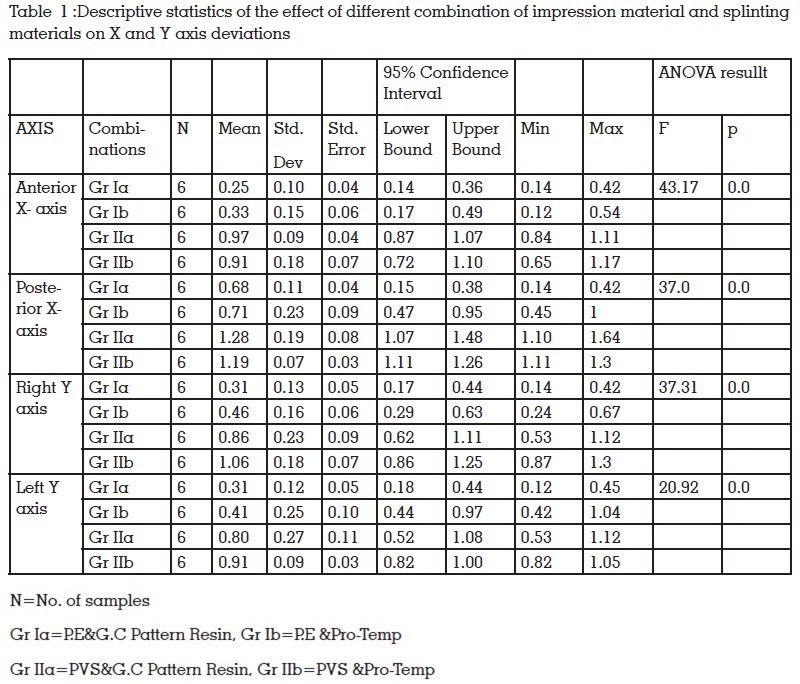
The following measurements were evaluated on the
reference model and the definitive cast replicas:
posterior x-axis (1 and 4); and anterior x-axis (2
and 3), left y-axis (1 and 2) and right y-axis (3
and 4) (Fig-8).
Data were analyzed with 2-way analysis of
variance (ANOVA) followed by Post hoc tukey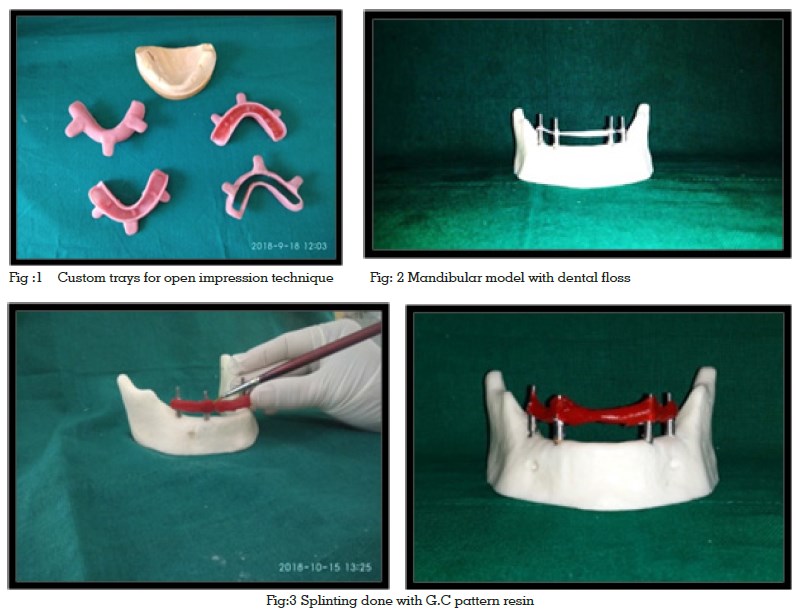
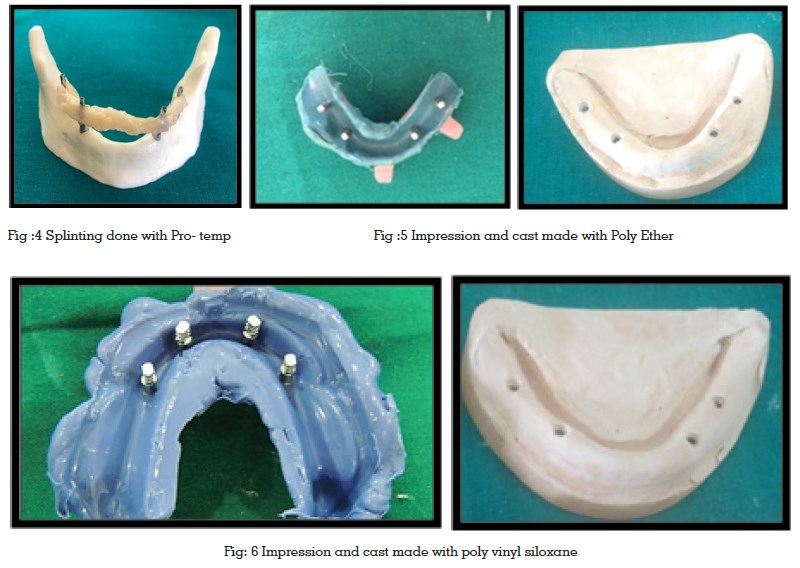
In the present study there were a total number of 36 test samples, divided into 2 groups and 4
subgroups of 6 sample each.
From this table it appears that for all measurements,
a significant variation exists in the magnitude of
deviations created by the different combinations of
splinting with impression materials. The interaction
between the combination Gr Ia produced the
minimum variation mean (0.25±0,10) and maximum
deviation with Gr IIa (0.97±0.09) combination. The
deviation obtained with Gr Ib (0.33±15) is closer
to Gr Ia (0.33±45). Gr IIa (0.97±0.09) is closer
to Gr IIb (0.91±0.18). Inter group comparison of
maximum values of variations in anterior x- axis
obtained with all these groups appeared to be
highly significant. This was evaluated with one way ANOVA results appeared to be highly significant
(F=43.17, p≤ 0.00 )
A multiple comparison followed by post hoc
Tukey’s test was performed to assess the extent
of variation made by different combinations in
different measurements revealed that subgroups
comprising of Gr Ia and Gr Ib showed significantly
less variations (p≤0.00) as compared to Gr IIa
and Gr IIb. The results are presented in table 5.
In Implant Prosthodontics, a successful result
can be achieved only when passively fitting
prostheses are fabricated. A passively fitting
prosthesis is a precondition for the maintenance
of osseointegration, and its use is dependent
upon the fact that the bone-implant interface allows limited movement of 10 mm; therefore, it
is unlike natural teeth, which are cushioned in
alveoli by periodontal fibers3. The impression must
be accurate to obtain the resulting master cast
which precisely duplicates the clinical situation.
The accuracy of the implant cast depends on many
factors; the type of impression material, implant
impression technique, the implant angulation,
the die material accuracy, and the master cast.7
Most research indicates that direct techniques
produce less distortion than indirect techniques11.
Polyether and poly vinyl siloxane impression
materials were used in present study as they
are known to provide superior reproduction
in comparision with other impression materials
in accordance with study carried by Sorrentio,
Alikhasi and Martin-Rus8,9,10. Because splinting with acrylic resin has yielded conflicting results.
This is an attempt made to evaluate the reliability
of bis-GMA (Pro-temp 4), and GC pattern resin
as splinting material. Polyether and poly vinyl
siloxane has been advocated as an impression
material for multiple implant -supported prosthesis
for edentulous patients. Both of these were used
as the impression materials. The overall accuracy
of the impression depends on deviation in the
X and Y axis. One of the drawbacks of direct
impression technique is rotation of impression
copings in the impression during fastening of
the implant analog. In X and Y axis both the
Groups I and Group II exhibits no differences
with the reference model. Possible limitations of
the present study design were that the measured
distortion did not completely evaluate the actual
three –dimensional distortion of the impressions.
Only the linear discrepancies in two planes were
evaluated and angular axis discrepancies were
not included in the study. Under clinical conditions
these differences may vary if the discrepancies
are present in other spatial planes .Thus, such
discrepancies may clinically result in a improper
fit of the prosthesis. However the results may vary
in clinical situations, therefore further clinical
studies may be required to evaluate and rectify the
problem in more depth considering the limitation
of previous and our present study to achieve
some other methods for the clinical applications. Only two combinations of impression materials
were included in the study. Further studies may be
conducted using different combinations as well.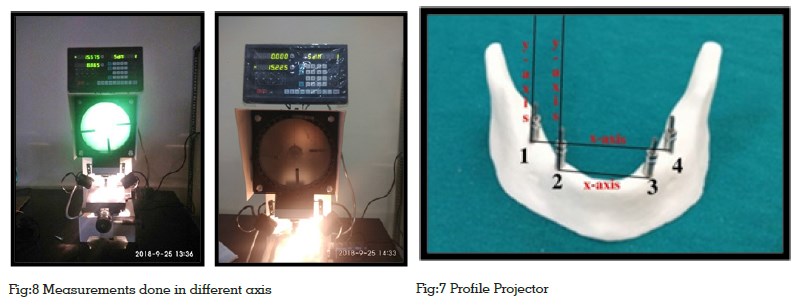
The surgical and prosthetic procedures for the placement of implant fixtures require a strict protocol to ensure osseointegration. Prosthesis should have a passive fit; an implant protected occlusion and made of a material which is biocompatible. An accurate impression that will ensure correct three-dimensional spatial orientation of the implant hex is of paramount importance to achieve prosthetic success. This study was conducted to compare the implant cast accuracy of multiple implants made with different splinting and impression materials. The following conclusions were arrived within the limitations of this in vitro study:
Possible limitations of the present study design were
that the measured distortion did not completely
evaluate the actual three –dimensional distortion
of the impressions. Only the linear discrepancies
in two planes were evaluated and angular axis
discrepancies were not included in the study. Under
clinical conditions these differences may vary if
the discrepancies are present in other spatial
planes. Therefore further clinical studies may be
required to evaluate and rectify the problem in
more depth. Only two combinations of impression
and splinting materials were included in the
study. Further studies may be conducted using
other combinations of impression and splinting
materials as well.